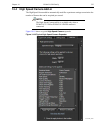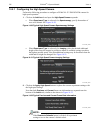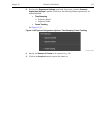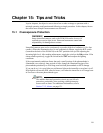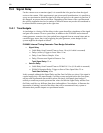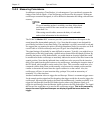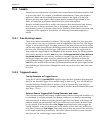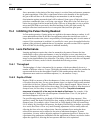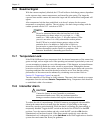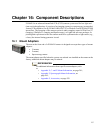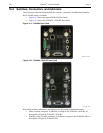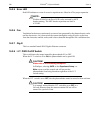
Chapter 15 Tips and Tricks 233
15.3 Lasers
Pulsed lasers are used in many experiments where a gated intensified camera might be used
to recover the signal. For example, in combustion measurements, a laser pulse might be
applied to a flame and the resulting fluorescence studied as the signal to be analyzed.
Because this short-term signal is much weaker than the integrated light emitted by the
flame, an intensified gated camera should be used to do the measurement.
Because available lasers differ so widely with respect to their characteristics and features,
there is no way to discuss specifically how to incorporate your particular laser into a
measurement system. It is necessary that users be familiar with the features, operation, and
limitations of their equipment. Nevertheless, the following observations might prove
helpful.
15.3.1 Free Running Lasers
These lasers behave essentially as oscillators. They typically exhibit little jitter from pulse
to pulse and are very easy to synchronize with the experiment. If the laser has a Pre-trigger
Output, it can be used to trigger the timing generator. If the interval between the Pre-trigger
and the laser output is long enough, the timing generator delay can then be adjusted to catch
the laser pulse following each pre-trigger. If the interval between the Pre-trigger and the
laser output isn’t long enough to accommodate all the insertion delays, the timing generator
delay can be adjusted to catch the
next laser pulse. As long as the laser’s jitter relative to
the period is small
, this is a perfectly valid way to operate. If the laser does not have a
Pre-trigger Output, one option is to use a pellicle mirror and a PIN diode to obtain the
timing generator trigger. Again, the timing generator delay could be adjusted to catch the
next laser pulse to achieve the necessary synchronization between the optical signal and the
photocathode gate at the camera, although this would cause at least every other laser pulse
to be lost.
15.3.2 Triggered Lasers
Timing Generator as Trigger Source
Using the PI-MAX4’s
SyncMASTER1 signal to trigger the laser eliminates the propagation
delay for the External Trigger (25 ns) and all timing is relative to
T
0
. You will still need to
consider the delays from the cable to the laser (1.5 ns/ft,) internal delay from trigger to
firing (laser dependent, 50 ns for example,) and the PI-MAX4's internal minimum allowable
gate delay (~25 ns.)
External Source Triggers Both Timing Generator and Laser
This is the more complex case because it contains many sources of delay that would have to
be considered. A carefully prepared Time Budget could prove invaluable in determining
what steps need to be taken to bring the gate and signal into coincidence at the camera. In
addition, actually measuring delays with a fast oscilloscope as previously described could
be very helpful. If the laser provides a
Pre-Trigger output that can be used to trigger the
Timing Generator, it may not be necessary to use mirrors or fiber-optic cable to delay the
laser pulse. If there is no
Pre-Trigger, then taking steps to delay the arrival of the laser pulse
at the sample would likely be necessary. The easiest solution would be to insert electrical
delay between the external trigger source and the laser.



